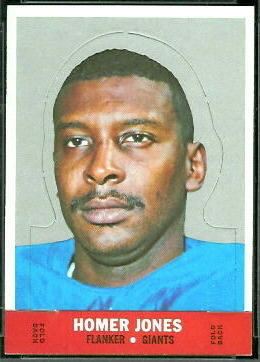Name Homer Jones | ||
 | ||
Date of birth (1941-02-18) February 18, 1941 (age 74) NFL draft 1963 / Round: 20 / Pick: 278 | ||
Homer Carroll Jones (born February 18, 1941 in Pittsburg, Texas) is a former American football wide receiver, who played for the National Football League's New York Giants from 1964 to 1969, and for the Cleveland Browns in 1970.
Contents
Early life
Six-foot-two and weighing 220 pounds, Jones was a cousin of Hall of Fame receiver Charley Taylor of the Washington Redskins and Browns' defensive end Joe Jones.
Jones attended Texas Southern College (now Texas Southern University), a historically black college, and starred in track and field as well as football, running the 100-yard and 220-yard dashes. He was drafted in 1963 by his hometown team, the Houston Oilers of the American Football League, but suffered a knee injury in training camp and was cut.
New York Giants and the "spike"
The Giants offered Jones a bus ticket to New York and payment for knee surgery. Known as "Rhino" to his teammates, he wore uniform number 45 in New York. Having seen players such as Giant teammate Frank Gifford and Green Bay Packers star Paul Hornung celebrate touchdowns by throwing the ball to fans in the stands, Jones decided to come up with his own post-touchdown maneuver. In a 1965 game, he scored a touchdown and threw the football down hard into the end zone. He called the move a "spike", and modern post-touchdown celebrations, including "touchdown dances", are said to have evolved from Jones' invention of spiking the ball.
In 1967, Jones had his best season, catching 49 passes for 1,209 yards, an average of 24.7 yards per catch, and 13 touchdowns, leading the NFL in receiving touchdowns. He was second in the league in combined rushing and receiving yards from scrimmage, behind Leroy Kelly of the Browns. He made the NFL's Pro Bowl that season and the next.
Later career and retirement
In January 1970, Jones was traded to the Browns in exchange for running back Ron Johnson and veteran defensive lineman Jim Kanicki. The Browns were in the market for a new wide receiver after having traded all-pro Paul Warfield to the Miami Dolphins.
In the team's first game of the 1970 NFL season on September 21, 1970 Cleveland Municipal Stadium, Jones returned the second-half kickoff against the New York Jets for a touchdown, a key play in the Browns' 31-21 win over the Jets in front of 85,703 fans. The crowd, officially the largest crowd in Browns' history, was a part of NFL history that evening in the first game ever played on ABC's Monday Night Football.
However, that touchdown would be the highlight of his one season with the Browns as knee injuries soon caught up with Jones. Soon after being traded to the St. Louis Cardinals in July 1971, he was forced to retire at age 29.
Career statistics
Jones finished his career with 224 receptions for 4,986 yards, an average of 22.3 yards per catch, and 38 touchdowns (36 receiving, one rushing, one kick return). His yard per catch ranks number one for all N.F.L. players in a career with at least 200 receptions.
